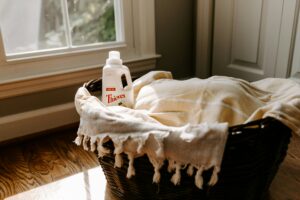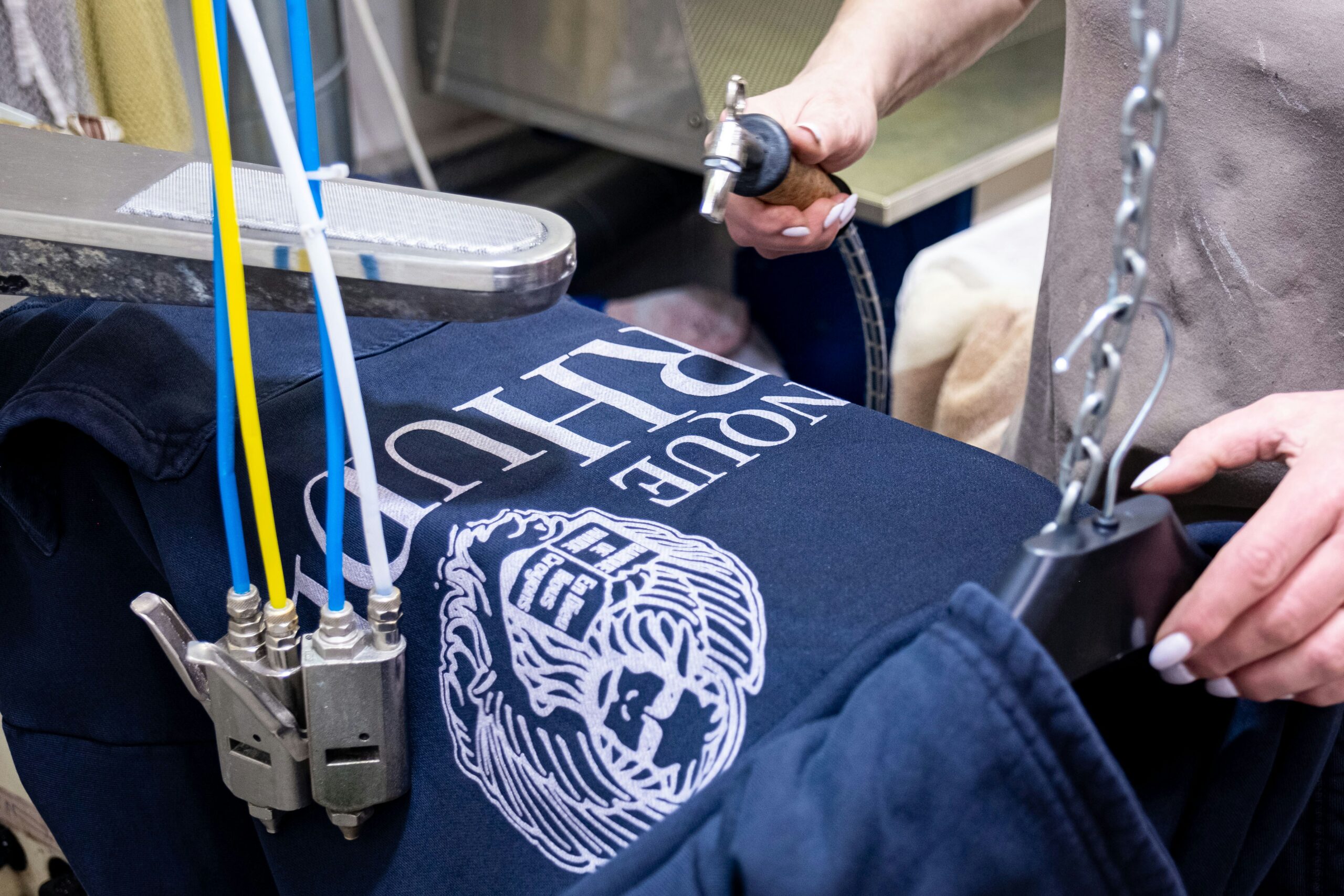Most of us know dry cleaning only to this extent: a cleaning process that uses chemical solvents to clean fabrics without water, and that’s all there is to it. But as to how dry cleaning works, how it differs from wet cleaning, or even what dry cleaning solvents are being used, we have little to no knowledge of all these aspects.
So to give you all the details surrounding the basics of dry cleaning, we’ve crafted this blog post so you can better understand how to care for your clothing and when to seek professional dry cleaning services.
The Dry Cleaning Process Explained
The dry-cleaning process is a method of cleaning clothes and fabrics using a solvent instead of detergents, and without using water. The entire process is designed to be gentle on fabrics and to remove tough stains that may not come out with regular washing. It is an effective way to keep delicate or special garments looking their best without subjecting them to the harshness of traditional laundry methods.
The 4-Step Process
Step 1: Inspection and Pre-treatment
The process begins with dry cleaners meticulously inspecting each garment. It involves sorting and tagging the clothing items, followed by a pre-treatment of any stains or spots.
Step 2: The Dry Cleaning Cycle
Next, the clothes are placed into a dry cleaning machine, which is a larger, more sophisticated version of a home washing machine.
Step 3: Spin and Dry
After the cleaning cycle, the clothes are dried and pressed to remove any remaining solvent and to give them a fresh, clean look. The solvent used in the dry-cleaning process is then filtered and recycled to be used again, making it a more sustainable option compared to traditional laundry methods.
Step 4: Post-Cleaning Treatment and Final Inspection
After drying the garments, professional dry cleaners won’t make them immediately available for collection. Instead, they conduct a thorough examination, checking for any remaining stains that may not have been completely removed during the washing process. If they discover lingering stains, they subject the clothing to a specialized spot treatment or even put them through another round of cleaning.
Types of Solvents Dry Cleaners Use on Garments

Choosing which dry cleaning chemical to use is similar to selecting the perfect tool for a delicate task – it shapes the outcome, determines efficiency, and influences the overall experience. While perchloroethylene (PERC) has long been popularly used, recent advancements have opened doors to a range of alternative solvents.
a. Perchloroethylene or PERC
The most commonly used solvent in dry cleaning is perchloroethylene. This solvent is effective in removing stains and dirt from fabrics, and it evaporates quickly, leaving the clothes dry and ready to wear. However, perchloroethylene has been found to be a potential human carcinogen, leading to health and environmental concerns. As a result, many dry cleaners are now shifting towards alternative solvents such as hydrocarbons, glycol ethers, and liquid silicone.
b. Hydrocarbon Solvents
Hydrocarbon solvents have become a popular substitute for perc. Made from purified petroleum, these solvents are praised for their efficient cleaning abilities without the accompanying health and environmental risks. With a softer impact on fabrics and a smaller environmental impact, hydrocarbon solvents offer an appealing choice for eco-conscious dry cleaners.
c. Solvent Mixtures
Some dry cleaners choose to use a combination of solvents in order to create a well-rounded and powerful cleaning solution. These mixtures typically include hydrocarbons, glycol ethers, and other substances, with the aim of utilizing the unique qualities of each component. The end result is a flexible and effective solvent that can effectively treat a wide range of fabrics and stains.
d. Glycol Ethers
Glycol ethers have gained popularity as solvents with a lower environmental impact. Derived from various glycols, these compounds are known for their mildness on fabrics and efficacy in stain removal. Glycol ethers offer an environmentally conscious choice without compromising on the cleaning power required in the dry cleaning process.
Exploring Other Alternatives
Beyond the aforementioned solvents, the dry cleaning industry is witnessing a surge in innovative alternatives. Liquid silicone, for instance, has gained attention for its eco-friendly attributes and gentle treatment of garments. Other plant-based and bio-based solvents are also entering the scene, promising effective cleaning without the environmental baggage associated with traditional options.
When to Choose Dry Cleaning Over Other Methods

Dry cleaning is more than just a cleaning method – it’s a strategic choice for certain garments and situations. Here’s when opting for dry cleaning makes practical sense:
1. Delicate Fabrics and Embellishments
When handling delicate fabrics like silk, wool, or garments adorned with intricate embellishments, dry cleaning takes the lead. The gentle touch of dry cleaning solvents coupled with the advancement of dry-cleaning machines ensures these fabrics and details remain intact, preventing damage that traditional washing methods might inflict.
2. Stains That Demand Expert Attention
Expert cleaners often handle stubborn stains, whether from red wine or grease, requiring their expertise. They employ specialized stain-removal techniques and solvents to effectively tackle even the most persistent marks, restoring your garments to their pristine condition.
3. Garments with Specific Care Labels
Garment care labels aren’t mere suggestions – they’re invaluable guides. When your favorite dress or suit explicitly recommends dry cleaning, it’s wise to heed that advice. Cleaning experts understand the nuances of different fabrics and meticulously follow care instructions.
4. Sensitive or Vintage Items
For sentimental or vintage garments that hold a special place in your wardrobe, dry cleaning is the safer bet. The process is designed to preserve the integrity of fabrics and prevent colors from bleeding, ensuring these cherished items stand the test of time.
5. Odor Removal
Dry cleaning excels at neutralizing lingering odors on garments. Whether it’s smoke, mildew, or other persistent scents, the solvents for dry cleaning effectively eliminate odors, leaving your clothes fresh and ready to wear.
6. Professional Garment Finishing
When aiming for that polished, professionally finished look, choose dry cleaning. The process includes careful pressing and steaming, ensuring your garments not only come out clean but also impeccably presented, ready for any occasion.
7. Time Efficiency
Dry cleaning ensures a swift turnaround, making it the preferred choice when you need your garments cleaned and ready in a short timeframe. Convenience and efficiency are key factors that make dry cleaning a go-to option for many.
Care Tips for Dry Cleaned Garments
- Air Them Out. After picking up your dry-cleaned items, let them breathe. Hang them in a well-ventilated area to allow any lingering solvent odors to dissipate. This simple step ensures your clothes not only look clean but also smell fresh.
- Storage Matters. Choose a cool, dry place for storing your dry-cleaned garments. Avoid plastic covers, as they can trap moisture and lead to musty odors. Opt for breathable garment bags or cotton covers to protect your clothes without compromising air circulation.
- Avoid Direct Sunlight. Prolonged exposure to sunlight can fade colors and weaken fabrics. So store your dry-cleaned items away from direct sunlight, and consider rotating your wardrobe to evenly distribute any potential fading.
- Address Stains Promptly. If you notice a stain post-dry cleaning, don’t panic. Instead, act promptly. Take the garment back to your dry cleaner, informing them of the issue. Delaying stain treatment may make it more challenging to achieve optimal results.
- Give a Rest Between Wear. Avoid excessive wear between cleaning sessions. Allowing your clothes to rest between uses not only preserves their shape but also minimizes the frequency of cleaning.
Get Perfectly Pressed Garments Only Here at The Cleaning Club!
Certain garments simply aren’t cut out for traditional washing methods. At The Cleaning Club, we’re here to provide you with expert care for all types of garments in your closet, most especially for those delicate and expensive ones that you can’t risk washing at home. Faded hues, worn-out fabric, stretched seams, or lost textures – we address them all, and more!
The Cleaning Club is the leading dry cleaning service provider in West, Los Angeles with the most affordable rates. ALL garments are just $4.50 with next-day turnaround, except on Sundays and holidays. All garments are cleaned, spotted, and expertly pressed in our on-site dairy cleaning plant, which guarantees they’re ready for you by 5:00 PM the following day.
We are always one call or text away anytime you need our professional dry cleaning and laundry services! Contact us at 310-836-9700.
Frequently Asked Questions
Q: What types of stains can be removed through dry cleaning?
A: Dry cleaning can effectively remove a variety of stains, including oil-based stains, grease, ink, and water-based stains. It is a great option for delicate fabrics that may be damaged by traditional washing methods.
Q: Is dry cleaning suitable for all types of clothing?
A: Dry cleaning is suitable for a wide range of clothing items, including suits, dresses, formal wear, and delicate fabrics such as silk and wool. It is also an ideal method for specialty items with embellishments or delicate trims.
Q: What is eco-friendly dry cleaning?
A: Eco-friendly dry cleaning refers to cleaning processes that use alternative solvents that are less harmful to the environment and human health. It may also involve energy-efficient machines and recycling of the solvent used in the cleaning process.
Q: How often should I dry clean my garments?
A: The frequency of dry cleaning depends on the fabric and how often the garment is worn. It is recommended to dry clean formal wear, suits, and delicate fabrics as needed, while everyday clothing may be cleaned less frequently.
Q: Is it possible to dry clean clothes at home?
A: While there are at-home dry cleaning kits available, professional dry cleaning is generally more effective in removing tough stains and preserving the condition of delicate garments. Consult with a local dry cleaning expert for the best approach for your specific items.
